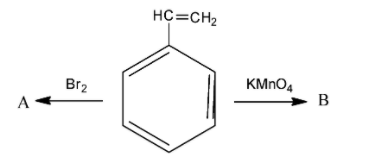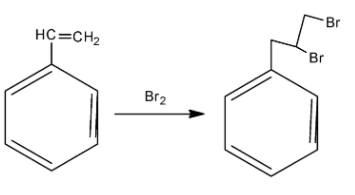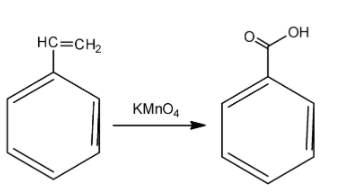
Compound A and B respectively are:

A. o-Bromostyrene, benzoic acid
B. p-bromostyrene, benzaldehyde
C. m-bromostyrene, benzaldehyde
D. styrene dibromide, benzoic acid

Answer
501.6k+ views
Hint: When bromine is added to alkenes, anti addition takes place. Whereas, when potassium permanganate is added to the double bond, it is replaced by two OH groups, from where the water molecule exits.
Complete step-by step solution:
In order to answer our question, we need to know the action of bromine and potassium permanganate on alkenes. In alkenes, bromine is added across the double bonds. Now, the compound we have been given in the question is called styrene. As we can see that styrene is a benzene ring that has a double bond at the tip. When bromine is reacted, it is added across the double bonds. Generally, during addition of bromine in double bonds, some amount of carbon tetrachloride is also used as a reagent. Remember that when bromine is added across double bonds, then both the bromide atoms are added on the same side, hence we obtain a cis isomer. The reaction is as follows:

So, we obtain styrene dibromide, which is the compound A. Now, in order to find out the compound B, we need to know about the action of potassium permanganate. Potassium permanganate is a strong oxidising agent and is used for oxidation of alkenes. Initially, the potassium permanganate converts the double bond of the carbon to two alcohol or -OH groups. However, two OH groups are very unstable. So, at a suitable temperature,

So, the compound we have obtained is benzoic acid. The correct answer for this question is option D.
NOTE: Addition of iodine to alkenes generally does not take place because the compounds get very unstable and eliminate iodine at high temperatures. The addition of
Complete step-by step solution:
In order to answer our question, we need to know the action of bromine and potassium permanganate on alkenes. In alkenes, bromine is added across the double bonds. Now, the compound we have been given in the question is called styrene. As we can see that styrene is a benzene ring that has a double bond at the tip. When bromine is reacted, it is added across the double bonds. Generally, during addition of bromine in double bonds, some amount of carbon tetrachloride is also used as a reagent. Remember that when bromine is added across double bonds, then both the bromide atoms are added on the same side, hence we obtain a cis isomer. The reaction is as follows:

So, we obtain styrene dibromide, which is the compound A. Now, in order to find out the compound B, we need to know about the action of potassium permanganate. Potassium permanganate is a strong oxidising agent and is used for oxidation of alkenes. Initially, the potassium permanganate converts the double bond of the carbon to two alcohol or -OH groups. However, two OH groups are very unstable. So, at a suitable temperature,

So, the compound we have obtained is benzoic acid. The correct answer for this question is option D.
NOTE: Addition of iodine to alkenes generally does not take place because the compounds get very unstable and eliminate iodine at high temperatures. The addition of
Latest Vedantu courses for you
Grade 9 | CBSE | SCHOOL | English
Vedantu 9 CBSE Pro Course - (2025-26)
School Full course for CBSE students
₹37,300 per year
Recently Updated Pages
Master Class 12 Economics: Engaging Questions & Answers for Success

Master Class 12 Maths: Engaging Questions & Answers for Success

Master Class 12 Biology: Engaging Questions & Answers for Success

Master Class 12 Physics: Engaging Questions & Answers for Success

Master Class 12 Business Studies: Engaging Questions & Answers for Success

Master Class 12 English: Engaging Questions & Answers for Success

Trending doubts
Which are the Top 10 Largest Countries of the World?

a Tabulate the differences in the characteristics of class 12 chemistry CBSE

Why is the cell called the structural and functional class 12 biology CBSE

Differentiate between homogeneous and heterogeneous class 12 chemistry CBSE

Derive an expression for electric potential at point class 12 physics CBSE

When was the first election held in India a 194748 class 12 sst CBSE




